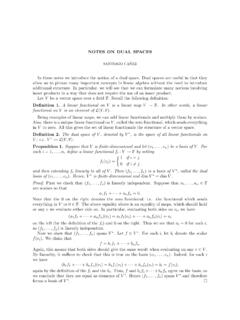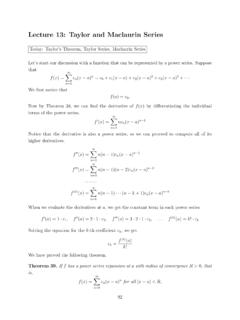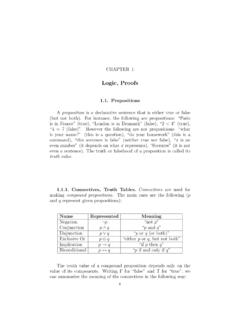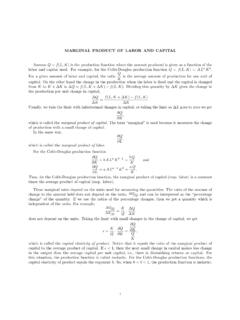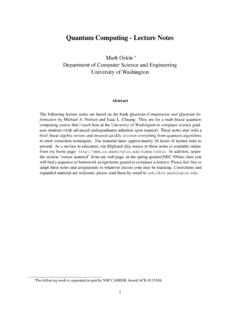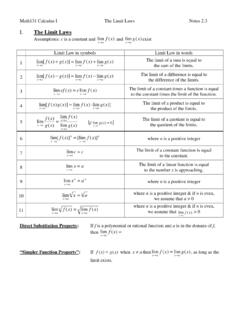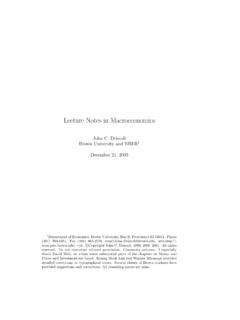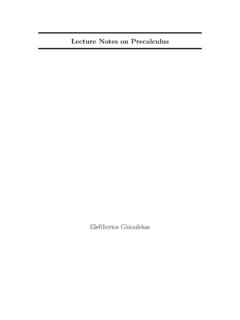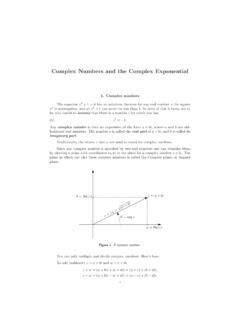Transcription of Notes on Calculus II Integral Calculus - NU Math Sites
1 22, , a Function(MeanValueTheorem) Functionsas Power Integrals119 IntroductionThesenotesareintendedtobe a summaryof themainideasincourseMATH214-2: Integral Calculus . I may keepworkingonthisdocument as thecoursegoes on,sothesenoteswillnotbe completelyfinisheduntil theendof Stewart: Calculus ,ConceptsandContexts(2th ed.), willfollow youfindany typos or errors,or youhave any suggestions,please,donothesitateto emailme,or usethewebformforfeedback theregionSunderthecurvey=f(x) fromatob,wherefis (x)SInordertoestimatethatareawe beginby dividingtheinterval[a, b]intonsubintervals[x0, x1], [x1, x2], [x2, x3],.., [xn 1, xn], eachof length x= (b a)/n(soxi=a+i x). thestripbetweenxi 1andxicanbe approximatedas theareaof therectangleof width xandheightf(x i), wherex iis a samplepoint in theinterval [xi, xi+1].
2 Sothetotalareaunderthecurve isapproximatelythesumn i=1f(x i) x=f(x 1) x+f(x 2) x+ +f(x n) x .Thisexpressionis betterthethinerthestripsare,andwe caniden-tifytheexactareaunderthegraphoff withthelimit:A= limn n i=1f(x i) xAslongasfis continuousthevalueof thelimitis independentof thesamplepointsx represented baf(x)dx, andis calleddefiniteintegralofffromatob: baf(x)dx= limn n i=1f(x i) xThesymbolsat thelefthistoricallywereintendedto meananinfinitesum,representedby a long S (theintegralsymbol ), of infinitelysmallamountsf(x)dx. Thesymboldxwas interpretedas thelengthofan infinitesimal interval, sortof what xbecomesforinfiniten. Thisinterpretationwas laterabandoneddueto thedifficultyof reasoningwithinfinitesimals,butwe : Notethatin intervalswheref(x) is negative thegraphofy=f(x) liesbelow thex-axisandthedefiniteintegraltakes a definiteintegralgives thenetareabetweenthegraphofy=f(x) andthex-axis, ,thesumoftheareasof theregionswherey=f(x) is above thex-axisminusthesumof theareasof theregionswherey=f(x) is below willsoonstudysimpleandef-ficient methods to evaluateintegrals,butherewe willlookat :Findthevalueof thedefiniteintegral 10x2dxfromitsdefinitionin termsof : We dividetheinterval[0,1] intonequalparts,soxi=i/nand x= 1/n.
3 Nextwe mustchoosesomepointx iin each subinterval[xi 1, xi]. Herewe willusetheright endpoint of theintervalx i= :n i=1(in)21/n=1n3n i=1i2=1n32n3+ 3n2+n6=2 + 3/n+ 2 : 10x2dx= limn 2 + 3/n+ 2/n26= check thattheresultdoes notdependonthesamplepoints used,let sredothecomputationusingnow theleftendpoint ofeach subinterval:n i=1(i 1n)21/n=1n3n i=1(i 1)2=1n32n3 3n2+n6=2 3/n+ 2 : 10x2dx= limn 2 3/n+ 2/n26= com-putingRiemannsumsusingxi= (xi 1+xi)/2 = midpoint of eachinterval as samplepoint. Thisyieldsthefollowingapproximationforth evalueof a definiteintegral: baf(x)dx n i=1f(xi) x= x[f(x1) +f(x2) + +f(xn)].Example: UsetheMidpoint Rulewithn= 5 to approximate : Thesubintervalsare[0, ],[ , ],[ , ],[ , ],[ ,1],themidpoints , , , , ,and x= 1/5, so 10x2dx 15[ + + + + ]= = ,which agreesupto theseconddecimalplacewiththeactualvalue1 show how theconceptofdefiniteintegralcanbe appliedto particularwe studytheproblemof findingthedistancetraveledby an objectwithvariablevelocity duringa certainperiod of thevelocityvwereconstant we couldjustmultiplyit by thetimet: distance=v t.
4 Otherwisewe canapproximatethetotaldistancetraveledby dividingthetotaltimeinterval into smallintervalsso thatin each of themthevelocity variesverylittleandcancanbe ,assumethatthebodystartsmovingattimetsta rtandfinishesat timetend, andthevelocity is variable, ,isa functionof timev=f(t). We dividethetimeinterval intonsmallintervals[ti 1, ti] of length t= (tend tstart)/n, choosesomeinstantt ibetweenti 1andti, andtakev=f(t i) as theapproximatevelocity ofthebodybetweenti 1andti. Thenthedistancetraveledduringthattimeint erval is approximatelyf(t i) t, andthetotaldistancecanbeapproximatedas thesumn i=1f(t i) tTheresultwillbe moreaccuratethelargerthenumber of subintervalsis, andtheexactdistancetraveledwillbelimitof theabove expressionasngoes to infinity:limn n i=1f(t i) tThatlimitturnsoutto bethefollowingdefiniteintegral: tendtstartf(t) theDefiniteIntegral.
5 (1)Integralof a constant: bac dx=c(b a).(2)Linearity:(a) ba[f(x) +g(x)]dx= baf(x)dx+ bag(x)dx.(b) bacf(x)dx=c baf(x)dx.(3) (a) caf(x)dx+ bcf(x)dx= baf(x)dx.(b) abf(x)dx= baf(x)dx,(c) aaf(x)dx= 0.(4)Comparison:(a)f(x) 0 baf(x)dx 0.(b)f(x) g(x) baf(x)dx bag(x)dx.(c)m f(x) M m(b a) baf(x)dx M(b a). a continuousfunctionandFisanantiderivative off, ,F (x) =f(x), then baf(x)dx=F(b) F(a).Example: Find : Anantiderivative ofx2isx3/3, hence: 10x2dx=[x33]10=133 033= anantiderivative of a functionf, ,F (x) =f(x), thenforany constantC,F(x) +Cis anotherantiderivative off(x). Thefamilyof allantiderivatives offis calledindefiniteintegraloffandrepresente d: f(x)dx=F(x)+C .Example: x2dx=x33+ canmake anintegraltablejustby reversinga tableof derivatives.(1) xndx=xn+1n+ 1+C(n6= 1).
6 (2) 1xdx= ln|x|+C.(3) exdx=ex+C.(4) axdx=axlna+C.(5) sinx dx= cosx+C.(6) cosxdx= sinx+C.(7) sec2x dx= tanx+ (8) csc2x dx= cotx+C.(9) secxtanx dx= secx+C.(10) cscxcotx dx= cscx+C.(11) dxx2+ 1= tan 1x+C.(12) dx 1 x2= sin 1x+C.(13) dxx x2 1dx= sec 1|x|+ a rateof changeisthetotalchange: baF (x)dx=F(b) F(a).Thisis justa restatementof applicationwe findthenetdistanceordisplace-ment,andthe totaldistancetraveledby anobjectthatmoves alongastraight linewithpositionfunctions(t). Thevelocity of theobjectisv(t)=s (t). Thenetdistanceor displacement isthedifferencebetweenthefinalandtheinit ialpositionsof theobject,andcanbe foundwiththefollowingintegral t2t1v(t)dt=s(t2) s(t1).In thecomputationof thedisplacement thedistancetraveledby theobjectwhenitmoves to theleft(whilev(t) 0) is subtractedfromthedistancetraveledtotheri ght (whilev(t) 0).
7 Ifwe want to findthetotaldistancetraveledwe needto addalldistanceswithapositivesign,andthis is accomplishedby integratingtheabsolutevalueof thevelocity: t2t1|v(t)|dt= : Findthedisplacement andthetotaldistancetraveledbyanobjecttha tmoves withvelocityv(t) =t2 t 6 fromt= 1 tot= : Thedisplacement is 41(t2 t 6)dx=[t33 t22 6t]41=(433 422 6 4) (133 122 6)= 323 ( 376)= 92 Inordertofindthetotaldistancetraveledwe needtoseparatetheintervalsin which thevelocity takes valuesofdifferent at whichv(t) =0, ,t2 t 6 = 0 t= 2 andt= 3. Sincewe areinterestedonlyin whathappensin [1,4]weonlyneedto lookat theintervals[1,3] and[3,4].Sincev(1)= 6,thevelocity is negative in [1,3],andsincev(4)= 6, thevelocity ispositive in [3,4].Hence: 41|v(t)|dt= 31[ v(t)]dt+ 43v(t)dt= 31(t2 t 6)dt+ 43(t2 t 6)dt=[ t33+t22+ 6t]31+[t33 t22 6t]43=223+176= Calculus (FTC)connectsthetwo branchesof cal- thefollowing:Supposefis continuouson[a, b].
8 Then:(1)Thefunctiong(x) = xaf(t)dtis anantiderivative off, ,g (x) =f(x).(2)(EvaluationTheorem)IfFis an antiderivative off, (x) =f(x), then baf(x)dx=F(b) F(a).Thetwo partsof thetheoremcanbe rewrittenlike this:(1)ddx xaf(t)dt=f(x).(2) baF (x)dx=F(b) F(a).Sothetheoremstatesthatintegrationan ddifferentiationarein-verseoperations, ,thederivative of anintegralof a functionyieldstheoriginalfunction,andthe integralof a derivative alsoyieldsthefunctionoriginallydifferent iated(uptoa constant).Example: Findddx : We solve thisproblemin two :g(x) = x20t3dt=[t44]x20=(x2)44=x84,henceg (x) =8x74= ,usingtheFTC:h(u) = u0t3dt h (u) = we haveg(x) =h(x2), hence(usingthechainrule):g (x) =h (x2) 2x= (x2)3 2x= a basedonthefollowingidentity betweendifferentials(whereuis a functionofx):du=u dx.
9 Hencewe canwrite: f(u)u dx= f(u)duor usinga slightlydifferent notation: f(g(x))g (x)dx= f(u)duwhereu=g(x).Example: Find 1 +x22x : Usingthesubstitutionu= 1 +x2we get 1 +x22x dx= u u dx= u du=23u3/2+C=23(1 +x2)3/2+ thetimetheonlyproblemin usingthismethod of integra-tionis findingtheright : Find cos2x : We want towritetheintegralas cosu du, socosu=cos2x u= 2x,u = 2. Sincewe donotseeanyfactor2 writeit, takingcareof dividingby 2 outsidetheintegral: cos2xdx=12 cos2x2dx=12 cosu u dx=12 cosu du=12sinu+C(always remember to undothesubstitution)=12sin2x+ generalwe needto lookattheintegrandas a functionof someexpression(whichwe willlateridentifywithu) multipliedby thede-rivative of : Find e x2x : We seethatxis almost ,thederivative of x2, so we usethesubstitutionu= x2,u = 2x, hencein orderto getu insidetheintegralwe dothefollowing: e x2x dx= 12 e x2 eu( 2x)dx du= 12 eudu= 12eu+C= 12e x2+ hardto seeuntilwe make somein-genioustransformationin : Find tanx : Heretheideais towritetanx=sinxcosxandusethat(cosx) = sinx, so we makethesubstitutionu= cosx,u = sinx.
10 Tanx dx= sinxcosxdx= u udx= 1udu= ln|u|+C= ln|cosx|+ generalwe needto identifyinsidetheintegralsomeexpressiono ftheformf(u)u , wherefis somefunctionwitha : Find exe2x+ : Let swrite exe2x+ 1dx=k f(u)u dx(wherekis someconstant to bedeterminedlater)andtryto identifythefunctionf,theargumentuanditsd erivativeu . Since(ex) =exit seemsnaturalto choseu=ex,u =ex, soe2x=u2and exe2x+ 1dx= u u2+ 1dx= 1u2+ 1du= tan 1u+C=tan 1(ex) + no much morethatcanbe saidin general,theway to learnmoreis justto substitutionof theformu= functionofx, we may tryachangeof variableof theformx= functionof someothervariablesuch ast,andwritedx=x (t)dt, wherex = derivative : Find 1 : Herewe writex= sint, sodx= cost dt,1 x2= 1 sin2t= cos2t, and 1 x2dx= cost xcost dt dx= cos2t dt.
